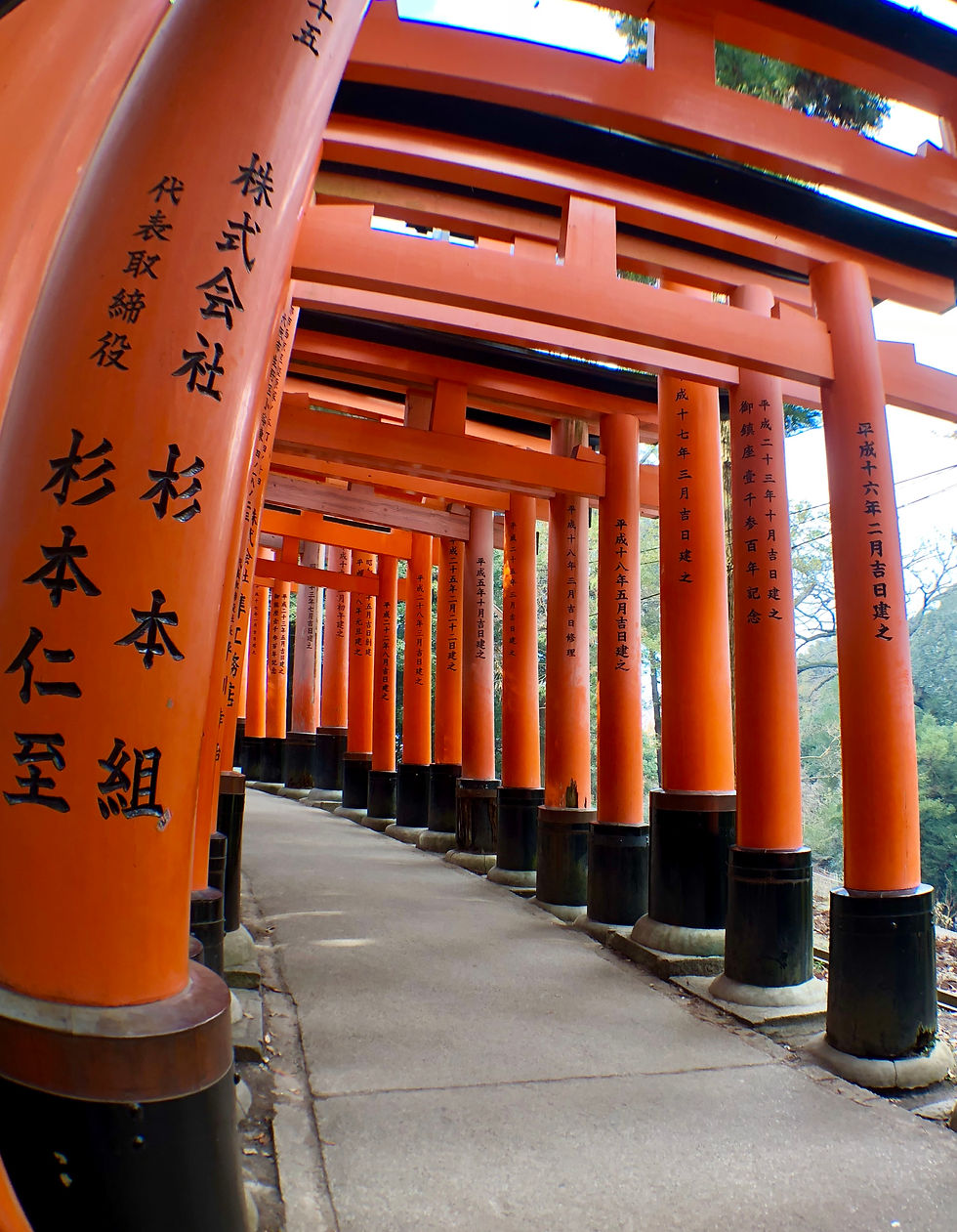Travel Piece: Kyoto, Japan
- Gaby Tiu

- Nov 24, 2020
- 4 min read
This creative nonfiction story covers my journey through the city of Kyoto, and getting to learn about Japanese culture and history in the process. (July 17, 2020)
Kyoto, Japan
The wind at first is unforgiving as it sweeps through the seemingly endless spanse of a crowd, people moving away from the train station and towards the densely packed landmarks. Despite the freezing weather at the beginning of January, and despite the infinite tourists, being here feels like a dream. Taking the train here for the day away from Osaka almost feels like taking a train to an entirely new world rather than just changing cities. And even within Kyoto, there are so many little alleyways, trails, aisles of food stalls, and sacred buildings to explore for as long as my mom and I are here. We are so eager to begin.
All over the most popular parts of the city, helpful signs with translations guide us as we make our way to our first destination, Fushimi Inari-taisha. Centuries old, it is a shrine composed of a tunnel of wooden gates dedicated to the god of rice and sake (“Fushimi Inari-Taisha”). The walk there makes for a miniature hike, slowed down from a normal hiking pace due to the line of patiently waiting tourists. I suddenly feel the weight of all the layers of winter clothing I am wearing now that the trees and foliage around us tame the wind, and I find myself walking up stairs and inclines to get to a landmark I know little about. The tiredness I feel in my legs is well worth it. At the end of our little hike, I am graced with the sight of a tunnel of what I could have believed to be hundreds of orange gates. They are placed only a few feet from one another, forming a beautifully vibrant tunnel with each pillar the glowing color of fire. Against the clouds of the January sky, the hues burn especially bright. I walk slowly, in awe of the country I find myself in. Japan is a trip I have wanted to make ever since I was a little girl and the excitement has not worn off in the slightest, even though it is 2018.

personal photo taken of Fushimi Inari-Taisha
As my mom and I stroll through the last gates of the Fushimi Inari-taisha shrine, we giddily check our phones to see where we’d like to go next. Kyoto is a gorgeous city. Its features are not made of shiny steel structures and glass windows, nor covered in screens with blaring advertisements, at least not in this area. As an outsider, I venture to guess the architecture around me is more traditional, more calm. The stone walkways split off into alleyways between buildings with hidden restaurants, cafés, tea shops, and boutiques with traditional Japanese garments. Some even offer kimonos for visitors to rent for wear in the city, and I occasionally pass by groups of women adorned in the elegant fabric.
Our next stop is at Kennin-ji Buddhist Temple. Even before we enter, we are asked to remove our shoes and leave them in cubbies by the entrance; we see signs asking us to refrain from speaking too loudly on the premises. We, as well as the limited amount of visitors let in at a time, quietly explore the temple. All around the sides of it are beautiful zen gardens with grounds filled with tiny, pale pebbles which have been tediously raked with lines to mimic the flow of water. Bigger stones sprinkled with patches of green moss sit in the middle of some of these raked circles in the pebbles. I take a moment to sit on a wooden porch in front of one of the gardens, breathing in and out, trying to memorize the relaxing atmosphere.
The rest of the temple is just as fantastic but what really captivates me (enough that I later buy prints of it at the small gift shop outside) is the ceiling of a large room which is covered in a black and white painting of twin dragons flying in a clouded sky. The low yellow light in this room bounces off of the white parts of the ceiling, making it look black and gold. I am stunned by the intricacy of the ink-work, the winding, ginormous bodies of the dragons, and the way the image demands my attention. Later on, it will be the only thing in this particular room that I remember quite so vividly.
After the temple, our day trip concludes with some food. Along a wide street, stalls with Japanese street food line the walkway where crowds gather to try the cheap but salivating-worthy food. Each stall offers only one or two selections but the made-from-scratch treats are cooked to perfection. The seafood is fresh and the flavors are neither bland nor overwhelming. My mom and I exchange yen for whole grilled squids in a mildly sweet glaze, thick slices of charred pork belly, warm rice drinks, and grilled balls of batter filled with octopus meat and vegetables. While we sit, eat, and people-watch at the conclusion of a perfect day, the clouds that line the winter sky begin to part, and a serene light blue peeks out from above.
Works Cited
“Fushimi Inari-Taisha Shrine.” Kyoto City Official Travel Guide, 2 Sept. 2019,
kyoto.travel/en/shrine_temple/180.html.

Comments